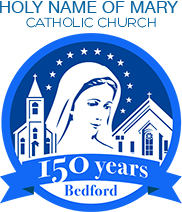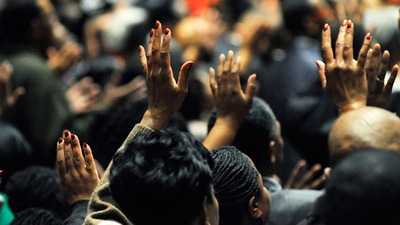Third Sunday of Easter
April 14, 2024 — Year B
Readings: Acts 3:13-15, 17-19 / Ps 4 / 1 Jn 2:1-5a / Lk 24:35-48
by Rev. Jay Biber, Guest Celebrant
Some of your fellow parishioners are away on a Cursillo weekend. If you are not familiar with that word, it’s a Spanish word which means “a short course.” In Christianity, it began almost a hundred years ago as a way of revitalizing the Faith among lay people.
And so, this is a women’s Cursillo going on this weekend, and like all Catholic stuff, there’s a specific order to it. There’s reason behind it. It’s ordered so it exposes the core elements of the Faith in an ordered way, but it’s also very personal. There’s a lot of witnessing to people’s own experiences. One of the things that happens is what they call the Emmaus Walk.
What we begin the gospel with today is the end of that walk. Two discouraged disciples encounter Christ on the way to Jerusalem, on the road. They are so discouraged and heartsick. They think that everything they hope for is gone. They meet the risen Christ, but they don’t recognize Him, and He explains it all. He lays it all out to them – this is how it had to happen. And then at the end, when did they recognize Him? This is the breaking of the bread; that’s when they recognize Him.
The women on Cursillo this weekend are from as far Charlottesville, Harrisonburg, Waynesboro, Roanoke, this whole part of the state. On this Emmaus Walk, two participants are paired with each other; they go out and walk for half an hour. They are a couple of days into this experience already, and it’s probably begun to shake up their hearts a little bit. This is the time when they’re saying, “This is the time; what’s going on in there?” They get a chance to talk; and they know they won’t be judged. They probably don’t know the other person to start with. But they know that God is at work, and it’s a good opportunity to put their faith into words.
At the core of our Faith is the capacity to take into the world, sort of like charity. It begins at home, but it doesn’t end there. The giving of witness, a testimony is a way of doing that. Telling the stories begins at home, but it doesn’t end there. The allusions to witnessing are strong. If you believe you have a gift to give, a gift around which you can organize your whole life, a gift that echoes through the ages, that gift can be shared with simple people, complicated people, rich people, poor people, educated, not educated people. We can give that gift to our children by telling them here’s where you are, you’re a member of this family, you belong here, you’re not just some piece adrift in the universe. As you’re at this table, you’re part of a great family, and it goes way, way back in time and every place on Earth.
Think about Peter in the Acts of the Apostles. He says the author of life you put to death, but God raised him from the dead. Of this we are witnesses. That’s what the apostles were doing – being witnesses and giving a testimony. And then of course in the gospel, it is Jesus himself. Thus, is it written – He’s laying out what you can do with your children and tell them the stories that say that Christ would suffer and rise from the dead. So, you don’t have to panic or run away. No – He said this was going to happen and that repentance for the forgiveness would be preached in his name. Where? To all the nations. And you are witnesses of these things.
In the summer of 1983, I had completed my seminary studies but had declined ordination in 1972. I went into the business world, enjoyed the heck out of it, and thought I’d be married with a family by 1982. But it didn’t happen, and I began to consider ordination. People asked if it was the hand of God, and I said no, I think it was the foot! He was nagging me. I thought I had a better idea, but long story short, I was in Boston at the time, and happened to meet the bishop; he asked if I wanted to go to school. I said no, I need to decide if I have enough faith for something like this, and I don’t know if I’d be any good at it. I needed to know if people would think I was any good at it. I said I don’t know what I think; you’ll have to throw me in the pool. So, he did; I started off at six months at St. Vincent DePaul by the shipyard in Newport News. That was a special blessing because it was way ahead of its time in a lot of ways. It was a very integrated parish. I sang with the folk group and a gospel choir both.
When summer came, I knew this would be a real test because I worked up at what was then called Medical College of Virginia in Richmond. I liked it, because it was a combination of the hospitals I had known in Boston, a little of Mass General, and a little bit of Boston City Hospitals – Mass General being the high-end teaching place for all the exotic stuff, and Boston City being a tough hospital in the inner city. MCV (now VCU Medical Center) was both. I spent ten weeks there in the summer of ’83. And I was a wreck at the end of it – we were on call two nights a week and saw all that comes in in the course of a night. My special unit was the burn unit in which people come from all over. I also had general surgery which included a lot of gunshot and knife wounds. These are tough places to be. I wondered if I could bring faith to this whole world, not just to Catholics. It was awful at the time, but it did the trick, and I decided that I could go on.
At the same time, I realized that I was going to benefit from being there. Broad Street in Richmond is a great dividing line between white and black neighborhoods. And there I was on campus at VCU staying in one of the dorms. And somebody recommended that I visit a Baptist Church right near here – Cedar Street Baptist. So, I would go to Mass at St. Peter’s (the original Cathedral for our diocese) near the state capital, and then I’d go to Cedar Street Baptist, and there I experienced my introduction into this brilliant black culture, where the whole idea of witnessing is very important. The gospel choir and the preaching are very important, and they would say that it’s not even a prayer until you break a sweat. There’s an energy to it; ours is beautiful but much more modest. There are so many beautiful ways to pray. So, we’d be singing and then there was a quiet, beautiful ritual to it. As it warmed up, you’d hear the Amen Corner.
We have our own Amen Corner; we have the back and forth which is a core of our worship. “The Lord be with you.” “And with your spirit.” “Lift up your hearts.” “We lift them up unto the Lord.” We do that throughout the whole liturgy. The antiphon is the back-and-forth prayer. In the black churches, there was a time when the church was the only place they could legally meet. The church was where everyone was at home, and as the preacher would warm up, people would say, “Come on now, preach!” to encourage. At some point, he would ask, “Can I get a witness?” They recognized the depth. Of course, this is a witness that’s gone through things that you can’t imagine. This is a witness that goes back how many generations? A witness where the only one was God; the only one was Christ.
What a lesson. You know, the centrality of the witness that would tell the story and break out into a testimony. I had an event this past week in Lexington where there were a lot of college kids. There was free pizza – what’s not to love? The program was on loss and joy and included a bunch of kids from W&L and VMI and also parishioners. I told them that I look at them differently than their professors do, because I look at you and I say, I want you to be ready to be able to your 3-year-old seven years from now, to be able to give a witness to your 10-year-old, to your 16-year-old, to put the story of your faith on your own lips, and learn how to do it with great confidence. I want to say that you want to have children, that you are not afraid, and I have the big story of our Faith to tell them, and the personal stories that go with it – the personal stories that illumine the big story. And I said that’s what I like to see. Of course, giving a witness is a little bit like dancing – you’re scared stiff because you move one foot and you don’t know what the other is going to do yet.
But what a beautiful gift to give – it’s how the faith gets spread to the corners of the earth. Our way of looking at things, telling the big story, as those women are doing on their Cursillo this weekend, telling their stories as well. It becomes an enormous gift, because I know that whatever happens to my child, in success or in moments of difficulties, Christ will be there. I’ll have words on my lips to say that we don’t have to run from anyone.
 540-586-8988
540-586-8988 

